Java文件操作和IO
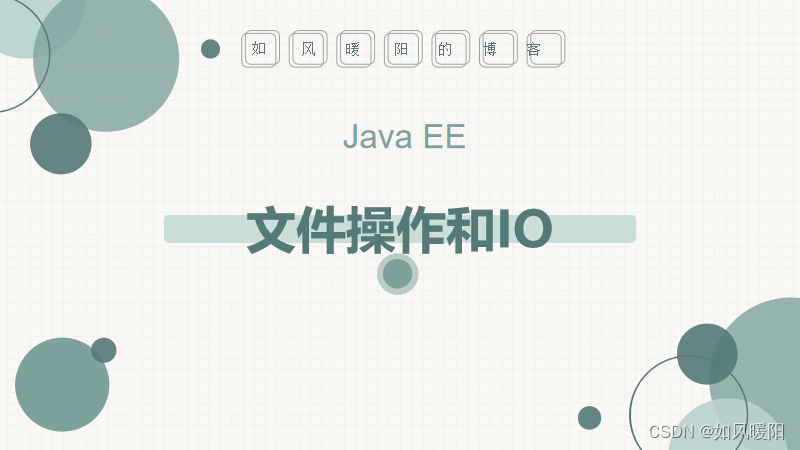
⭐️前言⭐️
咱们在Java中,一般谈到文件,都是指一个存储在磁盘上的文件(狭义的文件),如果抛开Java,站在系统角度来看,操作系统在管理很多软件资源和硬件设备的时候,都是把这些东西抽象成了一个一个的文件。
🍉博客主页: 🍁【如风暖阳】🍁
🍉精品Java专栏【JavaSE】、【Java数据结构】、【备战蓝桥】、【JavaEE初阶】
🍉欢迎点赞 👍 收藏 ⭐留言评论 📝私信必回哟😁🍉本文由 【如风暖阳】 原创,首发于 CSDN🙉
🍉博主将持续更新学习记录收获,友友们有任何问题可以在评论区留言
🍉博客中涉及源码及博主日常练习代码均已上传码云(gitee)
📍内容导读📍
- Java文件操作和IO
Java文件操作和IO
🍎 一:文件及文件操作
🍓1.文件流:
文件在程序中以流的形式来操作
数据从数据源(文件)到程序之间的路径为输入流,从程序到数据源(文件)之间的路径为输出流
🍓2.创建文件:
new File(String pathname)//路径构建
public void create01() { String pathname="d:\\news1.txt"; File file = new File(pathname); try { file.createNewFile(); System.out.println("创建成功"); } catch (IOException e) { e.printStackTrace(); } }new File(File parent,String child)//父目录文件+子路径
public void create02() { File parentFile = new File("d:\\"); String fileName="news2.txt"; File file=new File(parentFile,fileName); try { file.createNewFile(); System.out.println("创建成功02"); } catch (IOException e) { e.printStackTrace(); }new File(String parent,String child)//父目录+子路径
public void create03() { String parent="d:\\"; String child="news3.txt"; File file = new File(parent, child); try { file.createNewFile(); System.out.println("创建成功"); } catch (IOException e) { e.printStackTrace(); } }🍓3.获取文件信息
常用方法:
getName、getAbsolutePath、getParent、length、exists、isFile、isDirectory
🍓4.目录操作
d:\news1.txt 是否存在,如果存在就删除
public void m1() { String filePath = "e:\\news1.txt"; File file = new File(filePath); if (file.exists()) { if (file.delete()) { System.out.println(filePath + "删除成功"); } else { System.out.println(filePath + "删除失败"); } } else { System.out.println("该文件不存在..."); } }D:\demo02 是否存在,存在就删除,否则提示不存在
(在java编程中,目录也被当做文件)
public void m2() { String filePath="D:\\demo2"; File file = new File(filePath); if(file.exists()) { if(file.delete()) { System.out.println(filePath+"删除成功"); }else { System.out.println(filePath+"删除失败"); } }else { System.out.println("该目录不存在..."); }}判断 D:\demo\a\b\c 目录是否存在,如果存在就提示已经存在,否则就创建
public void m3() { String directoryPath="D:\\锤子\\a\\b\\c"; File file = new File(directoryPath); if(file.exists()) { System.out.println("目录存在"); }else { if(file.mkdirs()) { //创建一级目录使用mkdir() ,创建多级目录使用mkdirs() System.out.println("创建成功"); }else { System.out.println("创建失败"); } }}🍎 二:IO流原理及分类
🍓1.简述原理
Input/Output 实现数据的输入/输出操作(以流的方式进行)
🍓2.流的分类
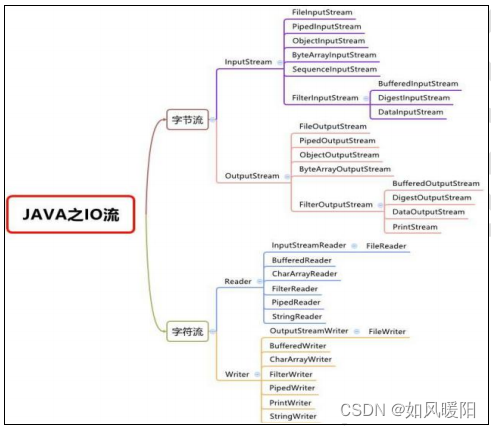
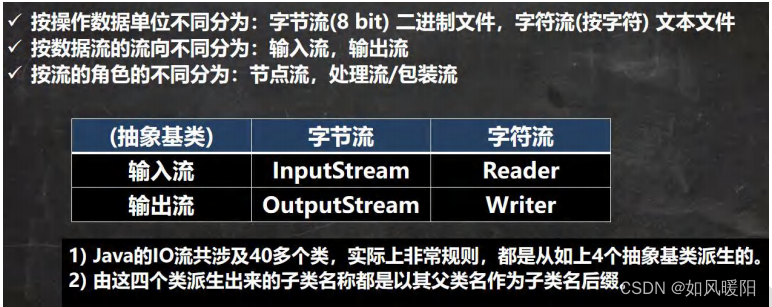
🍓3.FileInputStream
public void readFile01() { String filePath = "d:\\hello.txt"; int readData = 0; FileInputStream fileInputStream = null; try { //创建 FileInputStream 对象,用于读取 文件 fileInputStream = new FileInputStream(filePath); //从该输入流读取一个字节的数据。 如果没有输入可用,此方法将阻止。 //如果返回-1 , 表示读取完毕 while ((readData = fileInputStream.read()) != -1) { System.out.print((char)readData);//转成char显示 } } catch (IOException e) { e.printStackTrace(); } finally { //关闭文件流,释放资源. try { fileInputStream.close(); } catch (IOException e) { e.printStackTrace(); } } }- 单个字节的读取,效率比较低
- -> 使用 read(byte[] b)
public void readFile02() { String filePath = "d:\\hello.txt"; //字节数组 byte[] buf = new byte[8]; //一次读取8个字节. int readLen = 0; FileInputStream fileInputStream = null; try { //创建 FileInputStream 对象,用于读取文件 fileInputStream = new FileInputStream(filePath); //从该输入流读取最多b.length字节的数据到字节数组。此方法将阻塞,直到某些输入可用。 //如果返回-1 , 表示读取完毕 //如果读取正常, 返回实际读取的字节数 while ((readLen = fileInputStream.read(buf)) != -1) { System.out.print(new String(buf, 0, readLen));//显示 } } catch (IOException e) { e.printStackTrace(); } finally { //关闭文件流,释放资源. try { fileInputStream.close(); } catch (IOException e) { e.printStackTrace(); } } }🍓4.FileOutputStream
请使用 FileOutputStream 在 a.txt 文件,中写入 “hello,world”. 如果文件不存在,会创建
文件(注意:前提是目录已经存在.)
public void writeFile() { //创建 FileOutputStream对象 String filePath = "e:\\a.txt"; FileOutputStream fileOutputStream = null; try { //得到 FileOutputStream对象 //1. new FileOutputStream(filePath) 创建方式,当写入内容是,会覆盖原来的内容 //2. new FileOutputStream(filePath, true) 创建方式,当写入内容是,是追加到文件后面 fileOutputStream = new FileOutputStream(filePath, true); //写入一个字节 //fileOutputStream.write('H');// //写入字符串 String str = "hsp,world!"; //str.getBytes() 可以把 字符串-> 字节数组 //fileOutputStream.write(str.getBytes()); /* write(byte[] b, int off, int len) 将 len字节从位于偏移量 off的指定字节数组写入此文件输出流 */ fileOutputStream.write(str.getBytes(), 0, 3); } catch (IOException e) { e.printStackTrace(); } finally { try { fileOutputStream.close(); } catch (IOException e) { e.printStackTrace(); } }}🍓5.作业总结1
示例1
扫描指定目录,并找到名称中包含指定字符的所有普通文件(不包含目录),并且后续询问用户是否要
删除该文件
public class Demo8 { public static void main(String[] args) throws IOException { // 1. 让用户指定一个待扫描的根目录 和 要查询的关键词 System.out.println("请输入要扫描的根目录(绝对路径): "); Scanner scanner = new Scanner(System.in); String root = scanner.next(); File rootDir = new File(root); if (!rootDir.isDirectory()) { System.out.println("您输入的路径错误! 程序直接退出!"); return; } System.out.println("请输入要查找的文件名中包含的关键词: "); String token = scanner.next(); // 2. 递归的遍历目录 // result 表示递归遍历的结果. 就包含着所有带有 token 关键词的文件名. List<File> result = new ArrayList<>(); scanDir(rootDir, token, result); // 3. 遍历 result, 问用户是否要删除该文件. 根据用户的输入决定是否删除 for (File f : result) { System.out.println(f.getCanonicalPath() + " 是否要删除? (Y/n)"); String input = scanner.next(); if (input.equals("Y")) { f.delete(); } } } // 递归的来遍历目录, 找出里面所有符合条件的文件. private static void scanDir(File rootDir, String token, List<File> result) throws IOException { // list 返回的是一个文件名(String), 使用 listFiles 直接得到的是 File 对象, 用起来更方便一些. File[] files = rootDir.listFiles(); if (files == null || files.length == 0) { // 当前的目录是一个空的目录 return; } for (File f : files) { if (f.isDirectory()) { // 如果当前的文件是一个目录, 就递归的进行查找 scanDir(f, token, result); } else { // 如果当前文件是一个普通的文件, 就判定这个文件是否包含了待查找的关键词 if (f.getName().contains(token)) { result.add(f.getCanonicalFile()); } } } }}示例2
扫描指定目录,并找到名称或者内容中包含指定字符的所有普通文件(不包含目录)
注意:我们现在的方案性能较差,所以尽量不要在太复杂的目录下或者大文件下实验
public class Demo9 { public static void main(String[] args) throws IOException { Scanner scanner = new Scanner(System.in); // 1. 让用户输入一个路径. 待搜索的路径 System.out.println("请输入要扫描的根目录: "); String rootDir = scanner.next(); File rootFile = new File(rootDir); if (!rootFile.isDirectory()) { System.out.println("该目录不存在或者不是文件! 直接退出. "); return; } // 2. 再让用户输入一个查询词, 表示要搜索的结果中要包含这个词. System.out.println("请输入要查询的词: "); String query = scanner.next(); // 3. 遍历目录以及文件, 进行匹配 List<File> results = new ArrayList<>(); scanDirWithContent(rootFile, query, results); // 4. 把结果打印出来 for (File f : results) { System.out.println(f.getCanonicalPath()); } } private static void scanDirWithContent(File rootFile, String query, List<File> results) { File[] files = rootFile.listFiles(); if (files == null || files.length == 0) { // 针对空的目录, 直接返回 return; } for (File f : files) { if (f.isDirectory()) { scanDirWithContent(f, query, results); } else { if (f.getName().contains(query)) { // 看看文件名称中是否包含 results.add(f); } else if (isContentContains(f, query)) { // 看看文件内容中是否包含 results.add(f); } } } } private static boolean isContentContains(File f, String query) { // 打开 f 这个文件, 依次取出每一行结果, 去和 query 来进行一个 indexOf StringBuilder stringBuilder = new StringBuilder(); //实现了Closeable接口的类,可以放到try()中,自动完成资源回收 try (InputStream inputStream = new FileInputStream(f)) { //用标准输入流来读取文件内容 Scanner scanner = new Scanner(inputStream, "UTF-8"); while (scanner.hasNextLine()) { String line = scanner.nextLine(); stringBuilder.append(line + "\n"); } } catch (IOException e) { e.printStackTrace(); } // 只要结果不等于 -1, 就说明查到了. return stringBuilder.indexOf(query) != -1; }}🍓6.文件拷贝
思路分析:
- 创建文件的输入流 , 将文件读入到程序
- 创建文件的输出流, 将读取到的文件数据,写入到指定的文件.
public static void main(String[] args) { String srcfilePath="d:\\大美女.jpg"; String desfilePath="d:\\小美女.jpg"; FileInputStream fileInputStream=null; FileOutputStream fileOutputStream=null; try { fileInputStream= new FileInputStream(srcfilePath); fileOutputStream = new FileOutputStream(desfilePath); byte[]buf=new byte[1024]; int readLen=0; while ((readLen=fileInputStream.read(buf))!=-1) { fileOutputStream.write(buf,0,readLen); } } catch (IOException e) { e.printStackTrace(); } finally { try { if(fileInputStream!=null) fileInputStream.close(); if(fileOutputStream!=null) fileOutputStream.close(); } catch (IOException e) { e.printStackTrace(); } }}🍓7.文件字符流(FileReader、FileWriter)
FileReader:
/ * 单个字符读取文件 */ @Test public void readFile01() { String filePath = "d:\\story.txt"; FileReader fileReader = null; int data = 0; //1. 创建FileReader对象 try { fileReader = new FileReader(filePath); //循环读取 使用read, 单个字符读取 while ((data = fileReader.read()) != -1) { System.out.print((char) data); } } catch (IOException e) { e.printStackTrace(); } finally { try { if (fileReader != null) { fileReader.close(); } } catch (IOException e) { e.printStackTrace(); } } } / * 字符数组读取文件 */ @Test public void readFile02() { System.out.println("~~~readFile02 ~~~"); String filePath = "d:\\story.txt"; FileReader fileReader = null; int readLen = 0; char[] buf = new char[8]; //1. 创建FileReader对象 try { fileReader = new FileReader(filePath); //循环读取 使用read(buf), 返回的是实际读取到的字符数 //如果返回-1, 说明到文件结束 while ((readLen = fileReader.read(buf)) != -1) { System.out.print(new String(buf, 0, readLen)); } } catch (IOException e) { e.printStackTrace(); } finally { try { if (fileReader != null) { fileReader.close(); } } catch (IOException e) { e.printStackTrace(); } } }FileWriter:
public void fileWriter() { String filePath="d:\\note.txt"; FileWriter fileWriter=null; char[]chars=new char[]{'a','b','c'}; try { fileWriter=new FileWriter(filePath);// write(int):写入单个字符 fileWriter.write('H');// write(char[]):写入指定数组 fileWriter.write(chars);// write(char[],off,len):写入指定数组的指定部分 fileWriter.write("韩顺平教育".toCharArray(), 0, 3);// write(string):写入整个字符串 fileWriter.write(" 你好北京~"); fileWriter.write("风雨之后,定见彩虹");// write(string,off,len):写入字符串的指定部分 fileWriter.write("上海天津", 0, 2); //在数据量大的情况下,可以使用循环操作. } catch (IOException e) { e.printStackTrace(); } finally { try { if(fileWriter!=null) fileWriter.flush(); //fileWriter.close(); } catch (IOException e) { e.printStackTrace(); } }}🍓8.节点流和处理流

1.节点流是底层流(低级流),直接与数据源相接。
2.处理流(包装流)对节点流进行包装,消除不同节点流的实现差异,提供更方便的方法来完成输入输出。
处理流解析:
关闭处理流时,只需关闭外层流即可。
1.字符处理流
BufferedReader、BufferedWriter
BufferedReader
public void BufferedReader_() throws IOException { String filePath="d:\\story.txt"; BufferedReader bufferedReader = new BufferedReader(new FileReader(filePath)); String line; while ((line=bufferedReader.readLine())!=null) { System.out.println(line); } bufferedReader.close();}BufferedWriter
public void BufferedWriter_() throws IOException { String filePath="d:\\hello.txt"; BufferedWriter bufferedWriter = new BufferedWriter(new FileWriter(filePath)); bufferedWriter.write("\"hello, 韩顺平教育!\""); bufferedWriter.newLine(); bufferedWriter.write("1234"); bufferedWriter.newLine(); bufferedWriter.write("99ihsdkhf"); bufferedWriter.close();}综合使用,完成文本文件拷贝
注意:BufferedReader和BufferedWriter是按照字符操作,不能去操作二进制文件(图片,声音,视频,doc,pdf),否则会造成文件损坏。
public void BufferedCopy() { String srcFilePath="d:\\story.txt"; String destFilePath="d:\\aabbcc.txt"; BufferedReader br=null; BufferedWriter bw=null; String line; try { br=new BufferedReader(new FileReader(srcFilePath)); bw=new BufferedWriter(new FileWriter(destFilePath)); while ((line=br.readLine())!=null) { bw.write(line); bw.newLine(); } System.out.println("拷贝完毕..."); } catch (IOException e) { e.printStackTrace(); } finally { try { if(br!=null) br.close(); if(bw!=null) bw.close(); } catch (IOException e) { e.printStackTrace(); } }}2.字节处理流
BufferedInputStream、BufferedOutputStream
public void BufferedCopy02() { String srcFilePath="d:\\大美女.jpg"; String destFilePath="d:\\小美女.jpg"; BufferedInputStream bis=null; BufferedOutputStream bos=null; try { bis=new BufferedInputStream(new FileInputStream(srcFilePath)); bos=new BufferedOutputStream(new FileOutputStream(destFilePath)); byte[]buff=new byte[1024]; int readLen=0; while ((readLen=bis.read(buff))!=-1) { bos.write(buff,0,readLen); } System.out.println("拷贝完毕"); } catch (IOException e) { e.printStackTrace(); } finally { try { if(bis!=null) bis.close(); if(bos!=null) bos.close(); } catch (IOException e) { e.printStackTrace(); } } }3.对象处理流
ObjectOutputStream、ObjectInputStream
对数据的数据类型和数据的值都进行保存。
序列化保存数据
反序列化恢复数据
ObjectOutputStream
public class ObjectOutStream_ { public static void main(String[] args) throws Exception { //序列化后,保存的文件格式,不是存文本,而是按照他的格式来保存 String filePath = "e:\\data.dat"; ObjectOutputStream oos = new ObjectOutputStream(new FileOutputStream(filePath)); //序列化数据到 e:\data.dat oos.writeInt(100);// int -> Integer (实现了 Serializable) oos.writeBoolean(true);// boolean -> Boolean (实现了 Serializable) oos.writeChar('a');// char -> Character (实现了 Serializable) oos.writeDouble(9.5);// double -> Double (实现了 Serializable) oos.writeUTF("韩顺平教育");//String //保存一个dog对象 oos.writeObject(new Dog("旺财", 10, "日本", "白色")); oos.close(); System.out.println("数据保存完毕(序列化形式)"); }}ObjectInputStream
public class ObjectInputStream_ { public static void main(String[] args) throws IOException, ClassNotFoundException { //指定反序列化的文件 String filePath="d:\\test.dat"; ObjectInputStream ois=new ObjectInputStream(new FileInputStream(filePath)); //读取(反序列化)的顺序需要和你保存数据(序列化)的顺序一致 //否则会出现异常 System.out.println(ois.readInt()); System.out.println(ois.readBoolean()); System.out.println(ois.readChar()); System.out.println(ois.readDouble()); System.out.println(ois.readUTF()); System.out.println(ois.readObject()); ois.close(); }}注意事项:
- 读写顺序要求一致
- 要求序列化或者反序列化的对象都需要实现Serializable接口
4.标准输入输出流

5.转换流
InputStreamReader 、OutputStreamWriter
乱码问题引出转换流的必要性:
默认读取文件按照UTF-8的形式来读取,但若文件的保存方式不是UTF-8,将会出现乱码的情况
所以需要通过转换流来指定文件的读取方式
InputStreamReader
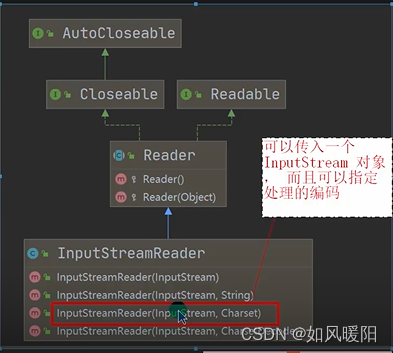
* 演示使用 InputStreamReader 转换流解决中文乱码问题 * 将字节流 FileInputStream 转成字符流 InputStreamReader, 指定编码 gbk/utf-8public class InputStreamReader_ { public static void main(String[] args) throws IOException { String filePath="d:\\a.txt"; InputStreamReader isr=new InputStreamReader(new FileInputStream(filePath),"gbk"); BufferedReader br=new BufferedReader(isr); //上两步和在一起 //BufferedReader br=new BufferedReader(new InputStreamReader(new FileInputStream(filePath),"gbk")); String s= br.readLine(); System.out.println("读取内容"+s); br.close(); }}OutputStreamWriter
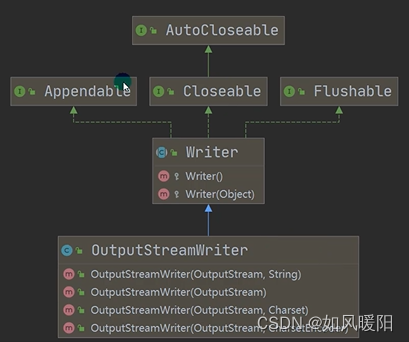
* 把FileOutputStream 字节流,转成字符流 OutputStreamWriter * 指定处理的编码 gbk/utf-8/utf8public class OutputStreamWriter_ { public static void main(String[] args) throws IOException { String filePath = "d:\\hsp.txt"; String charSet = "utf-8"; OutputStreamWriter osw = new OutputStreamWriter(new FileOutputStream(filePath), charSet); osw.write("hi, 韩顺平教育"); osw.close(); System.out.println("按照 " + charSet + " 保存文件成功~"); }}当处理纯文本数据时,如果使用字符流效率更高,并且可以有效解决中文问题,建议将字节流转换为字符流
6.打印流
只有输出流,没有输入流
PrintStream(字节打印流)、PrintWriter(字符打印流)
PrintStream

public class PrintStream_ { public static void main(String[] args) throws IOException { PrintStream out=new PrintStream(System.out); out.println("hello,world"); out.write("刘格你好".getBytes(StandardCharsets.UTF_8)); out.close(); //写入文件 System.setOut(new PrintStream("d:\\demo.txt")); System.out.println("还得是你"); }}PrintWriter
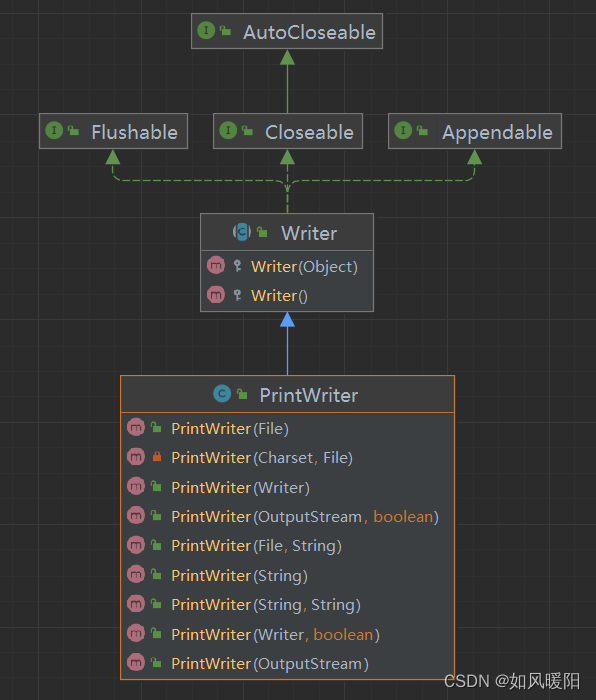
public class PrintWriter_ { public static void main(String[] args) throws IOException { PrintWriter printWriter=new PrintWriter(new FileWriter("d:\\test.dat")); printWriter.write("风雨之后,定见彩虹"); printWriter.close(); }}8.Properties类
是专门用于读写配置文件的集合类
配置文件的格式:
键=值
键=值
代码示例:
1.使用Properties 类来读取mysql.properties 文件
public class Properties02 { public static void main(String[] args) throws IOException { //1. 创建Properties 对象 Properties properties = new Properties(); //2. 加载指定配置文件 properties.load(new FileReader("src\\mysql.properties")); //3. 把k-v显示控制台 properties.list(System.out); //4. 根据key 获取对应的值 String user = properties.getProperty("user"); String pwd = properties.getProperty("pwd"); System.out.println("用户名=" + user); System.out.println("密码是=" + pwd); }}2.使用Properties 类来创建 配置文件, 修改配置文件内容
public class Properties03 { public static void main(String[] args) throws IOException { Properties properties=new Properties(); //创建 //1.如果该文件没有key 就是创建 //2.如果该文件有key ,就是修改 properties.setProperty("charset", "utf8"); properties.setProperty("user", "汤姆");//注意保存时,是中文的 unicode码值 properties.setProperty("pwd", "888888"); //将k-v 存储文件中即可 properties.store(new FileWriter("src\\mysql2.properties"),null); //properties.store()后边这个参数为注解 System.out.println("保存配置文件成功~"); }}🍓9.作业总结2
1:
(1) 在判断e盘下是否有文件夹mytemp ,如果没有就创建mytemp
(2) 在e:\mytemp 目录下, 创建文件 hello.txt
(3) 如果hello.txt 已经存在,提示该文件已经存在,就不要再重复创建了
(4) 并且在hello.txt 文件中,写入 hello,world~
public class HomeWork01 { public static void main(String[] args) throws IOException { String directoryPath="d:\\mytemp"; File file=new File(directoryPath); if(!file.exists()) { if(file.mkdirs()) { System.out.println("创建 " + directoryPath + " 创建成功" ); } else { System.out.println("创建 " + directoryPath + " 创建失败" ); } } String filePath="d:\\mytemp\\hello.txt"; file=new File(filePath); if(!file.exists()) { if(file.createNewFile()) { System.out.println(filePath + " 创建成功~"); BufferedWriter bw=new BufferedWriter(new FileWriter(file)); bw.write("hello, world~~ 韩顺平教育"); bw.close(); } else { System.out.println(filePath + " 创建失败~"); } }else { System.out.println(filePath + " 已经存在,不在重复创建..."); } }}2:
使用BufferedReader读取一个文本文件,为每行加上行号,
再连同内容一并输出到屏幕上。
public class HomeWork02 { public static void main(String[] args) { String filePath="d:\\story.txt"; BufferedReader br=null; String line; int count=0; try { br=new BufferedReader(new InputStreamReader(new FileInputStream(filePath),"gbk")); while((line= br.readLine())!=null) { System.out.println(++count+" "+line); } } catch (IOException e) { e.printStackTrace(); } finally { try { if(br!=null) { br.close(); } } catch (IOException e) { e.printStackTrace(); } } }}3:
(1) 要编写一个dog.properties name=tom age=5 color=red
(2) 编写Dog 类(name,age,color) 创建一个dog对象,读取dog.properties 用相应的内容完成属性初始化, 并输出
(3) 将创建的Dog 对象 ,序列化到 文件 d:\dog.txt 文件
public class HomeWork03 { public static void main(String[] args) throws IOException { String path="src\\dog.properties"; Properties properties=new Properties(); properties.load(new FileReader(path)); String name=properties.getProperty("name"); int age= Integer.parseInt(properties.getProperty("age")); String color=properties.getProperty("color"); Dog dog=new Dog(name,age,color); System.out.println(dog); String filePath="d:\\dog.txt"; ObjectOutputStream oos=new ObjectOutputStream(new FileOutputStream(filePath)); oos.writeObject(dog); oos.close(); } //反序列化 @Test public void test() throws IOException, ClassNotFoundException { String filePath="d:\\dog.txt"; ObjectInputStream ois=new ObjectInputStream(new FileInputStream(filePath)); Dog dog=(Dog)ois.readObject(); System.out.println(dog); ois.close(); }}class Dog implements Serializable { String name; int age; String color; public Dog(String name, int age, String color) { this.name = name; this.age = age; this.color = color; } @Override public String toString() { return "Dog{" + "name='" + name + '\'' + ", age=" + age + ", color='" + color + '\'' + '}'; }}⚡️最后的话⚡️
总结不易,希望uu们不要吝啬你们的👍哟(^U^)ノ~YO!!如有问题,欢迎评论区批评指正😁



